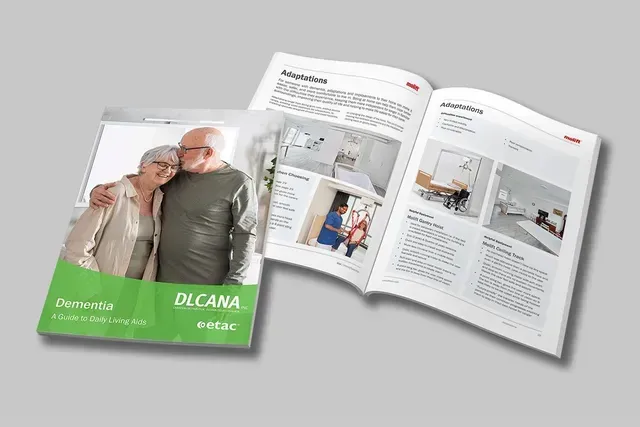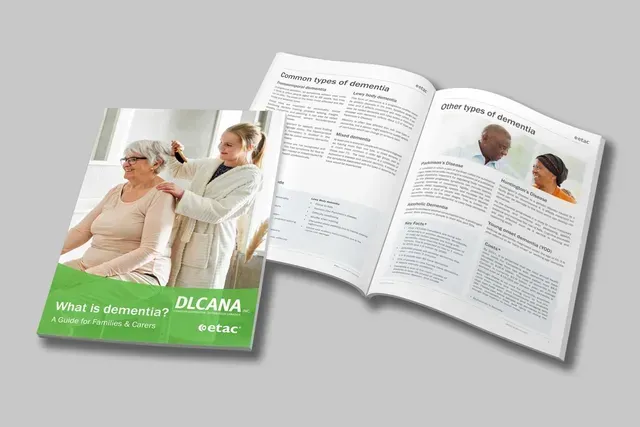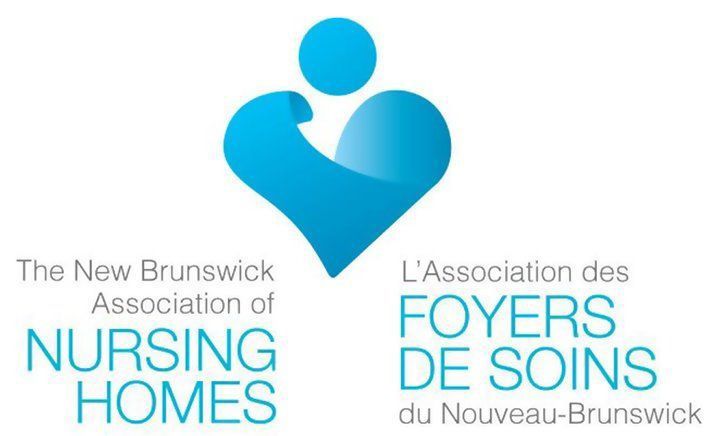WHAT IS DEMENTIA
A Guide for Families & Carers
Dementia is a syndrome (a group of related symptoms) for a range of progressive conditions that affect the brain. There are over 200 subtypes, most common are: Alzheimer’s disease, vascular dementia, dementia with Lewy bodies, frontotemporal dementia, and mixed dementia.
We have produced a short GUIDE FOR FAMILIES & CARERS that looks at the difficulties experienced by someone with dementia with the inclusion of our GUIDE TO DAILY LIVING AIDS that gives examples of helpful equipment that could help continue to carry out these purposeful and meaningful activities that can stimulate and preserve their skills for longer.
Dementia damages the nerve cells (neurons) in the brain. Messages can’t be sent to and from the brain effectively, preventing the body from functioning normally.
There are lots of other causes and no two types of dementia are the same. In different types of dementia there is damage to different parts of the brain.
Whatever type of dementia is diagnosed and what part of the brain is affected, each person will experience dementia differently. Dementia can affect a person at any age, but is more commonly diagnosed in people over 65.
Dementia often starts by affecting short-term memory and problems recalling things that happened recently. But dementia can also affect the way people think, speak, perceive things, feel, and behave.
There is a huge amount of social stigma and barriers still associated with dementia and as it progresses, social isolation and loneliness become more likely. Many people with dementia, and their families, become depressed and anxious. This can be because of embarrassment, loss of confidence, lack of appropriate stimulation, routine and purposeful activity.*
Other Symptoms experienced
- Difficulties concentrating
- Problems planning, thinking things through
- Struggling with familiar daily tasks, eg following a recipe or using a bank card
- Issues with language and communication, eg trouble remembering the right word or keeping up with a conversation
- Problems judging distances (even though eyesight is fine)
- Aggression, mood changes and difficulties controlling emotions.
References
This guide has been put together using information from the following sources:
- https://www.alz.org/ca/dementia- alzheimers-canada.asp
- https://www.alzheimer.ca/en
- https://www.cihi.ca/en/dementia-in- canada/dementia-in-canada-summary
- https://www.nhs.uk/conditions/ dementia/about/
*Rachel Hills, Advanced Occupational Therapist, Whiston Mental Health Liaison Team
COMMON TYPES OF
DEMENTIA
Alzheimers disease
The most common type of dementia in the UK and accounts for around 60% of diagnoses, although it is comparatively rare for under-65s. It is a physical condition caused by changes in the structure of the brain due to a build-up of proteins. This results in ‘plaques’ and ‘tangles’ which damage the brain cells’ ability to transmit messages and eventually lead to brain cell death.
Research suggests that changes in the brain can occur up to ten years before a person starts to show symptoms of Alzheimer’s disease. The symptoms are usually mild at the beginning and gradually worsen over time.
Vascular dementia
Vascular dementia is the second most common type of dementia (around 17%). It is caused by problems in the blood supply to the brain cells, commonly due to strokes or a series of small strokes, called Transient Ischaemic Attacks (TIAs), which cause areas of localised cell damage in the brain. Changes in a person’s condition because of a stroke or TIA are often sudden, before their condition plateaus.
The signs and symptoms of vascular dementia depend on which area of the brain has been affected. Language, reading, writing and communication can be affected. Memory problems may not be an issue initially, if this area of the brain has not been damaged, but may occur later.
Symptoms may include
Alzheimers disease
- Difficulty remembering recent events while having a good memory for past events
- Poor concentration
- Difficulty recognising people or objects
- Poor organisation skills
- Confusion and disorientation
- Slow, muddled, or repetitive speech
- Withdrawal from family and friends
- Problems with decision making, problem solving, planning, and sequencing tasks
Vascular dementia
- Problems with planning or organising, making decisions or problem solving
- Confusion, disorientation, poor concentration
- Visuospatial skills - problems perceiving objects in three dimensions
- Problems with reasoning and communication
- Delusions, hallucinations
- Changes in behaviour - agitation, aggressive, depression, disturbed sleep pattern
- Reduced mobility
COMMON TYPES OF
DEMENTIA
Frontotemporal dementia
- Difficulty remembering recent events while having a good memory for past events
- Poor concentration
- Difficulty recognising people or objects
- Poor organisation skills
- Confusion and disorientation
- Slow, muddled, or repetitive speech
- Withdrawal from family and friends
- Problems with decision making, problem solving, planning, and sequencing tasks
Lewy body dementia
This form of dementia is a progressive condition caused by protein deposits in the brain. Symptoms worsen over time and it affects movement and motor control. It can also be called dementia with Lewy bodies or Parkinson’s disease with dementia (affects about 1/3 of those with Parkinson’s Disease).
Memory is often less affected than with other types of dementia, but a person might experience sudden periods of confusion which can change on an hourly basis.
Mixed dementia
At least one in every ten people with dementia is diagnosed as having more than one type, or mixed dementia. It is much more common in older age groups, such as those over 75. The most common is a combination of Alzheimer’s disease and vascular dementia. A mixture of the symptoms associated with the types of dementia they have would be experienced.
Symptoms may include
Frontal dementia
- Changes in behaviour and personality
- Apathy
- Obsessive or repetitive behaviours
- Loss of empathy
- Changes in appetite and food eaten
- Difficulties with decision making, problem solving and concentration
Primary progressive aphasia
- Language difficulties & speech problems
- Reduced comprehension
- Loss of understanding of familiar words difficulty recognising people or objects
Lewy Body dementia
- Prone to falls
- Tremors (like Parkinson’s disease)
- Difficulty swallowing
- Shuffle when walking
- Disrupted sleep patterns due to intense dreams/ nightmares
- Visual and auditory hallucinations due to the nerve cell damage.
OTHER TYPES OF DEMENTIA

Parkinson’s Disease
A condition in which a part of the brain called the substantia nigra, loses nerve cells resulting in a reduction of a substance called dopamine, important for regulating body movement. As the disease progresses symptoms can include tremor, shaking, slowness of movement, rigidity, problems with balance, sleep, swallowing, speech and increase the risk of falls. About a third of people with Parkinson’s develop dementia, usually in the later stages. This is known as ‘Parkinson’s disease with dementia’ or Lewy body dementia.
Alcoholic Dementia
Caused by excessive alcohol consumption over a prolonged period. More common in people in their 40s and 50s.
Huntington’s Disease
Huntington’s disease is a genetic disorder caused by a faulty gene on chromosome 4. It affects movement but there can be damage to the brain which can develop into dementia.
As the disease progresses it is likely to cause involuntary movements and problems with swallowing, speech, balance and increase the risk of falls. Cognitive processes are also affected such as a decline in thinking and reasoning skills.
Young onset dementia (YOD)
Defined as dementia diagnosed under the age of 65. It is also referred to as ‘early onset’ or ‘working age’ dementia.
Key Facts*
- Over 747,000 Canadians are living with Alzheimer's or another dementia. Worldwide, at least 44 million people are living with dementia—more than the total population of Canada. This is projected to rise to 1 million by 2025 and 1.6 million by 2040.
- 209,600 people will develop dementia this year – one every 3 minutes
- 1 in 6 people over 80 have dementia
- 70% of people in care homes have dementia or severe memory problems.
- Dementia is one of the main causes of disability in later life ahead of cancer, cardiovascular disease, and stroke
Cost*
By 2031, it is projected that the total annual health care costs for Canadians with dementia will have doubled those from two decades earlier, from $8.3 billion to $16.6 billion. The cost of dementia to Canada is currently $3.9 billion a year; an average annual cost of $5,220 in 2021 to an estimated cost of $9,375 per person with dementia by 2031.
Although there is no cure for dementia, scientists and researchers are working hard to find one. Until then, support and treatments are available that can help with symptoms and managing daily life. These can allow people with dementia to lead active, purposeful lives and carry on doing the things that matter to them most.
* Alzheimer’s Society






